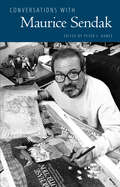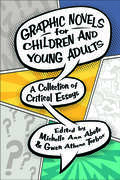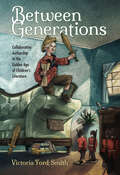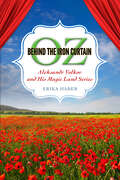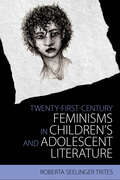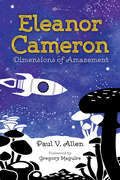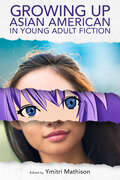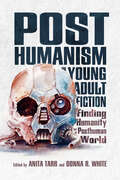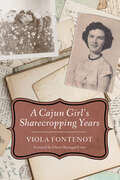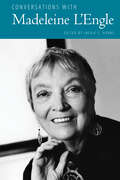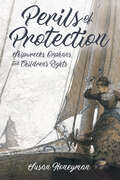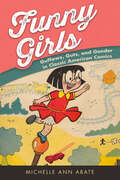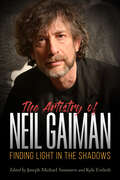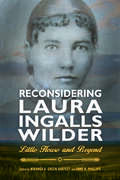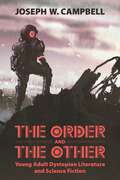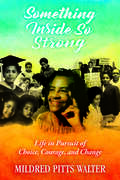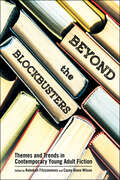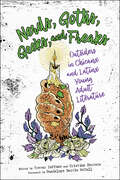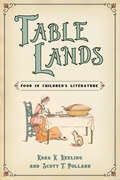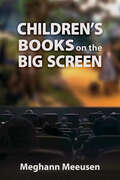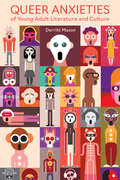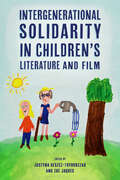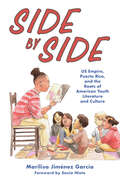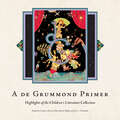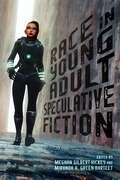- Table View
- List View
Conversations with Maurice Sendak (Literary Conversations Series)
by Peter C. KunzeMaurice Sendak (1928–2012) stands out as one of the most respected, influential authors of the twentieth century. Though primarily known as a children’s book writer and illustrator, he did not limit himself to these areas. He saw himself first and foremost as an artist. In this collection of interviews, Sendak presents himself as a writer, illustrator, set designer, and librettist. From his early work with Randall Jarrell and Ruth Krauss through his later work with Tony Kushner and Spike Jonze, Sendak worked as a collaborator with a passion for the arts.The interviews here, many of which are hard to find or previously unpublished, span from 1966 through 2011. They show not only Sendak’s shifting artistic interests, but also changes in how he understood himself and his craft. What emerges is a portrait of an author and an artist who was alternately solemn and playful, congenial and irascible, sophisticated and populist. The man who showed millions of children and adults alike what’s cooking in the night kitchen and where the wild things are, Sendak remains an American original who redefined the picture book and changed children’s literature—and its readers—forever.
Graphic Novels for Children and Young Adults: A Collection of Critical Essays (Children's Literature Association Series)
by Michelle Ann Abate & Gwen Athene TarboxWith contributions by Eti Berland, Rebecca A. Brown, Christiane Buuck, Joanna C. Davis-McElligatt, Rachel Dean-Ruzicka, Karly Marie Grice, Mary Beth Hines, Krystal Howard, Aaron Kashtan, Michael L. Kersulov, Catherine Kyle, David E. Low, Anuja Madan, Meghann Meeusen, Rachel L. Rickard Rebellino, Rebecca Rupert, Cathy Ryan, Joe Sutliff Sanders, Joseph Michael Sommers, Marni Stanley, Gwen Athene Tarbox, Sarah Thaller, Annette Wannamaker, and Lance WeldyOne of the most significant transformations in literature for children and young adults during the last twenty years has been the resurgence of comics. Educators and librarians extol the benefits of comics reading, and increasingly, children's and YA comics and comics hybrids have won major prizes, including the Printz Award and the National Book Award. Despite the popularity and influence of children's and YA graphic novels, the genre has not received adequate scholarly attention.Graphic Novels for Children and Young Adults is the first book to offer a critical examination of children's and YA comics. The anthology is divided into five sections, structure and narration; transmedia; pedagogy; gender and sexuality; and identity, that reflect crucial issues and recurring topics in comics scholarship during the twenty-first century. The contributors are likewise drawn from a diverse array of disciplines--English, education, library science, and fine arts. Collectively, they analyze a variety of contemporary comics, including such highly popular series as Diary of a Wimpy Kid and Lumberjanes; Eisner award-winning graphic novels by Gene Luen Yang, Nate Powell, Mariko Tamaki, and Jillian Tamaki; as well as volumes frequently challenged for use in secondary classrooms, such as Raina Telgemeier's Drama and Sherman Alexie's The Absolutely True Diary of a Part-Time Indian.
Between Generations: Collaborative Authorship in the Golden Age of Children's Literature (Children's Literature Association Series)
by Victoria Ford SmithWinner of the Children’s Literature Association’s 2019 Book AwardBetween Generations is a multidisciplinary volume that reframes children as powerful forces in the production of their own literature and culture by uncovering a tradition of creative, collaborative partnerships between adults and children in nineteenth- and early twentieth-century England. The intergenerational collaborations documented here provide the foundations for some of the most popular Victorian literature for children, from Margaret Gatty's Aunt Judy's Tales to Robert Louis Stevenson's Treasure Island. Examining the publication histories of both canonical and lesser-known Golden Age texts reveals that children collaborated with adult authors as active listeners, coauthors, critics, illustrators, and even small-scale publishers. These literary collaborations were part of a growing interest in child agency evident in cultural, social, and scientific discourses of the time. Between Generations puts these creative partnerships in conversation with collaborations in other fields, including child study, educational policy, library history, and toy culture. Taken together, these collaborations illuminate how Victorians used new critical approaches to childhood to theorize young people as viable social actors. Smith's work not only recognizes Victorian children as literary collaborators but also interrogates how those creative partnerships reflect and influence adult-child relationships in the world beyond books. Between Generations breaks the critical impasse that understands children's literature and children themselves as products of adult desire and revises common constructions of childhood that frequently and often errantly resign the young to passivity or powerlessness.
Oz behind the Iron Curtain: Aleksandr Volkov and His Magic Land Series (Children's Literature Association Series)
by Erika HaberRecipient of the 2018 Outstanding Faculty Research Achievement Award in the Department of Languages, Literatures, and Linguistics at Syracuse UniversityIn 1939, Aleksandr Volkov (1891-1977) published Wizard of the Emerald City, a revised version of L. Frank Baum's The Wonderful Wizard of Oz. Only a line on the copyright page explained the book as a "reworking" of the American story. Readers credited Volkov as author rather than translator. Volkov, an unknown and inexperienced author before World War II, tried to break into the politically charged field of Soviet children's literature with an American fairy tale. During the height of Stalin's purges, Volkov adapted and published this fairy tale in the Soviet Union despite enormous, sometimes deadly, obstacles.Marketed as Volkov's original work, Wizard of the Emerald City spawned a series that was translated into more than a dozen languages and became a staple of Soviet popular culture, not unlike Baum's fourteen-volume Oz series in the United States. Volkov's books inspired a television series, plays, films, musicals, animated cartoons, and a museum. Today, children's authors and fans continue to add volumes to the Magic Land series. Several generations of Soviet Russian and Eastern European children grew up with Volkov's writings, yet know little about the author and even less about his American source, L. Frank Baum. Most Americans have never heard of Volkov and know nothing of his impact in the Soviet Union, and those who do know of him regard his efforts as plagiarism.Erika Haber demonstrates how the works of both Baum and Volkov evolved from being popular children's literature and became compelling and enduring cultural icons in both the US and USSR/Russia, despite being dismissed and ignored by critics, scholars, and librarians for many years.
Twenty-First-Century Feminisms in Children's and Adolescent Literature (Children's Literature Association Series)
by Roberta Seelinger TritesOver twenty years after the publication of her groundbreaking work, Waking Sleeping Beauty: Feminist Voices in Children’s Novels, Roberta Seelinger Trites returns to analyze how literature for the young still provides one outlet in which feminists can offer girls an alternative to sexism. Supplementing her previous work in the linguistic turn, Trites employs methodologies from the material turn to demonstrate how feminist thinking has influenced literature for the young in the last two decades. She interrogates how material feminism can expand our understanding of maturation and gender—especially girlhood—as represented in narratives for preadolescents and adolescents. Twenty-First-Century Feminisms in Children’s and Adolescent Literature applies principles behind material feminisms, such as ecofeminism, intersectionality, and the ethics of care, to analyze important feminist thinking that permeates twenty-first-century publishing for youth. The structure moves from examinations of the individual to examinations of the individual in social, environmental, and interpersonal contexts. The book deploys ecofeminism and the posthuman to investigate how embodied individuals interact with the environment and via the extension of feministic ethics how people interact with each other romantically and sexually. Throughout the book, Trites explores issues of identity, gender, race, class, age, and sexuality in a wide range of literature for young readers, such as Kate DiCamillo’s Flora and Ulysses, Jacqueline Woodson’s Brown Girl Dreaming, and Rainbow Rowell’s Eleanor & Park. She demonstrates how shifting cultural perceptions of feminism affect what is happening both in publishing for the young and in the academic study of literature for children and adolescents.
Eleanor Cameron: Dimensions of Amazement
by Paul V. AllenEleanor Cameron (1912-1996) was an innovative and genre-defying author of children's fiction and children's literature criticism. From her beginnings as a librarian, Cameron went on to become a prominent and respected voice in children's literature, writing one of the most beloved children's science fiction novels of all time, The Wonderful Flight to the Mushroom Planet, and later winning the National Book Award for her time fantasy The Court of the Stone Children.In addition, Eleanor Cameron played an often vocal role in critical debates about children's literature. She was one of the first authors to take up literary criticism of children's novels and published two influential books of criticism, including The Green and Burning Tree. One of Cameron's most notable acts of criticism came in 1973, when she wrote a scathing critique of Roald Dahl's Charlie and the Chocolate Factory. Dahl responded in kind, and the result was a fiery imbroglio within the pages of the Horn Book Magazine. Yet despite her many accomplishments, most of Cameron's books went out of print by the end of her life, and her star faded.This biography aims to reinsert Cameron into the conversation by taking an in-depth look at her tumultuous early life in Ohio and California, her unforgettably forceful personality and criticism, and her graceful, heartfelt novels. The biography includes detailed analysis of the creative process behind each of her published works and how Cameron's feminism, environmentalism, and strong sense of ethics are reflected in and represented by her writings. Drawn from over twenty interviews, thousands of letters, and several unpublished manuscripts in her personal papers, Eleanor Cameron is a tour of the most exciting and creative periods of American children's literature through the experience of one of its valiant purveyors and champions.
Growing Up Asian American in Young Adult Fiction (Children's Literature Association Series)
by Ymitri MathisonWinner of the Children’s Literature Association’s 2020 Edited Book AwardContributions by Hena Ahmad, Linda Pierce Allen, Mary J. Henderson Couzelis, Sarah Park Dahlen, Lan Dong, Tomo Hattori, Jennifer Ho, Ymitri Mathison, Leah Milne, Joy Takako Taylor, and Traise Yamamoto Often referred to as the model minority, Asian American children and adolescents feel pressured to perform academically and be disinterested in sports, with the exception of martial arts. Boys are often stereotyped as physically unattractive nerds and girls as petite and beautiful. Many Americans remain unaware of the diversity of ethnicities and races the term Asian American comprises, with Asian American adolescents proving to be more invisible than adults. As a result, Asian American adolescents are continually searching for their identity and own place in American society. For these kids, being or considered to be American becomes a challenge in itself as they assert their Asian and American identities; claim their own ethnic identity, be they immigrant or American-born; and negotiate their ethnic communities. The contributors to Growing Up Asian American in Young Adult Fiction focus on moving beyond stereotypes to examine how Asian American children and adolescents define their unique identities. Chapters focus on primary texts from many ethnicities, such as Chinese, Korean, Filipino, Japanese, Vietnamese, South Asian, and Hawaiian. Individual chapters, crossing cultural, linguistic, and racial boundaries, negotiate the complex terrain of Asian American children’s and teenagers’ identities. Chapters cover such topics as internalized racism and self-loathing; hypersexualization of Asian American females in graphic novels; interracial friendships; transnational adoptions and birth searches; food as a means of assimilation and resistance; commodity racism and the tourist gaze; the hostile and alienating environment generated by the War on Terror; and many other topics.
Posthumanism in Young Adult Fiction: Finding Humanity in a Posthuman World (Children's Literature Association Series)
by Anita Tarr and Donna R. WhiteContributions by Torsten Caeners, Phoebe Chen, Mathieu Donner, Shannon Hervey, Angela S. Insenga, Patricia Kennon, Maryna Matlock, Ferne Merrylees, Lars Schmeink, Anita Tarr, Tony M. Vinci, and Donna R. White For centuries, humanism has provided a paradigm for what it means to be human: a rational, unique, unified, universal, autonomous being. Recently, however, a new philosophical approach, posthumanism, has questioned these assumptions, asserting that being human is not a fixed state but one always dynamic and evolving. Restrictive boundaries are no longer in play, and we do not define who we are by delineating what we are not (animal, machine, monster). There is no one aspect that makes a being human—self-awareness, emotion, artistic expression, or problem-solving—since human characteristics reside in other species along with shared DNA. Instead, posthumanism looks at the ways our bodies, intelligence, and behavior connect and interact with the environment, technology, and other species. In Posthumanism in Young Adult Fiction: Finding Humanity in a Posthuman World, editors Anita Tarr and Donna R. White collect twelve essays that explore this new discipline's relevance in young adult literature. Adolescents often tangle with many issues raised by posthumanist theory, such as body issues. The in-betweenness of adolescence makes stories for young adults ripe for posthumanist study. Contributors to the volume explore ideas of posthumanism, including democratization of power, body enhancements, hybridity, multiplicity/plurality, and the environment, by analyzing recent works for young adults, including award-winners like Paolo Bacigalupi's Ship Breaker and Nancy Farmer's The House of the Scorpion, as well as the works of Octavia Butler and China Miéville.
A Cajun Girl's Sharecropping Years
by Viola FontenotWinner of the 2019 Humanities Book of the Year from the Louisiana Endowment for the HumanitiesToday sharecropping is history, though during World War II and the Great Depression sharecropping was prevalent in Louisiana's southern parishes. Sharecroppers rented farmland and often a small house, agreeing to pay a one-third share of all profit from the sale of crops grown on the land. Sharecropping shaped Louisiana's rich cultural history, and while there have been books published about sharecropping, they share a predominately male perspective. In A Cajun Girl's Sharecropping Years, Viola Fontenot adds the female voice into the story of sharecropping.Spanning from 1937 to 1955, Fontenot describes her life as the daughter of a sharecropper in Church Point, Louisiana, including details of field work as well as the domestic arts and Cajun culture. The account begins with stories from early life, where the family lived off a gravel road near the woods without electricity, running water, or bathrooms, and a mule-drawn wagon was the only means of transportation. To gently introduce the reader to her native language, the author often includes French words along with a succinct definition. This becomes an important part of the story as Fontenot attends primary school, where she experienced prejudice for speaking French, a forbidden and punishable act. Descriptions of Fontenot's teenage years include stories of going to the boucherie; canning blackberries, figs, and pumpkins; using the wood stove to cook dinner; washing and ironing laundry; and making moss mattresses. Also included in the texts are explanations of rural Cajun holiday traditions, courting customs, leisure activities, children's games, and Saturday night house dances for family and neighbors, the fais do-do.
Conversations with Madeleine L'Engle (Literary Conversations Series)
by Jackie C. HorneConversations with Madeleine L’Engle is the first collection of interviews with the beloved children’s book author best known for her 1962 Newbery Award–winning novel, A Wrinkle in Time. However, Madeleine L’Engle's accomplishments as a writer spread far beyond children’s literature. Beginning her career as a literary novelist for adults, L’Engle (1918–2007) continued to write fiction for both young and old long after A Wrinkle in Time. In her sixties, she published personal memoirs and devotional texts that explored her relationship with religion. At the time of her death, L’Engle was mourned by fans of her children’s books and the larger Christian community.L’Engle’s books, as well as her life, were often marked by contradictions. A consummate storyteller, L’Engle carefully crafted and performed a public self-image via her interviews. Weaving through the documentable facts in these interviews are partial lies, misdirections, and wish-fulfillment fantasies. But, when read against her fictions, these “truths” can help us see L’Engle more deeply—what she wanted for herself and for her children, what she believed about good and evil, and what she thought was the right way and the wrong way to be a family—than if she had been able to articulate the truth more directly.The thirteen interviews collected here reveal an amazing feat of authorial self-fashioning, as L’Engle transformed from novelist to children’s author to Christian writer and attempted to craft a public persona that would speak to each of these different audiences in meaningful, yet not painfully revealing, ways.
Perils of Protection: Shipwrecks, Orphans, and Children's Rights (Children's Literature Association Series)
by Susan HoneymanWinner of the Children’s Literature Association’s 2020 Honor Book AwardUnrecognized in the United States and resisted in many wealthy, industrialized nations, children’s rights to participation and self-determination are easily disregarded in the name of protection. In literature, the needs of children are often obscured by protectionist narratives, which redirect attention to parents by mythologizing the supposed innocence, victimization, and vulnerability of children rather than potential agency.In Perils of Protection: Shipwrecks, Orphans, and Children's Rights, author Susan Honeyman traces how the best of intentions to protect children can nonetheless hurt them when leaving them unprepared to act on their own behalf. Honeyman utilizes literary parallels and discursive analysis to highlight the unchecked protectionism that has left minors increasingly isolated in dwindling social units and vulnerable to multiple injustices made possible by eroded or unrecognized participatory rights.Each chapter centers on a perilous pattern in a different context: “women and children first” rescue hierarchies, geographic restriction, abandonment, censorship, and illness. Analysis from adventures real and fictionalized will offer the reader high jinx and heroism at sea, the rush of risk, finding new families, resisting censorship through discovering shared political identity, and breaking the pretenses of sentimentality.
Funny Girls: Guffaws, Guts, and Gender in Classic American Comics
by Michelle Ann AbateFor several generations, comics were regarded as a boys’ club—created by, for, and about men and boys. In the twenty-first century, however, comics have seen a rise of female creators, characters, and readers. While this sudden presence of women and girls in comics is being regarded as new and noteworthy, the observation is not true for the genre’s entire history. Throughout the first half of the twentieth century, the medium was enjoyed equally by both sexes, and girls were the protagonists of some of the earliest, most successful, and most influential comics. In Funny Girls: Guffaws, Guts, and Gender in Classic American Comics, Michelle Ann Abate examines the important but long-overlooked cadre of young female protagonists in US comics during the first half of the twentieth century. She treats characters ranging from Little Orphan Annie and Nancy to Little Lulu, Little Audrey of the Harvey Girls, and Li’l Tomboy—a group that collectively forms a tradition of Funny Girls in American comics. Abate demonstrates the massive popularity these Funny Girls enjoyed, revealing their unexplored narrative richness, aesthetic complexity, and critical possibility. Much of the humor in these comics arose from questioning gender roles, challenging social manners, and defying the status quo. Further, they embodied powerful points of collection about both the construction and intersection of race, class, gender, and age, as well as popular perceptions about children, representations of girlhood, and changing attitudes regarding youth. Finally, but just as importantly, these strips shed light on another major phenomenon within comics: branding, licensing, and merchandising. Collectively, these comics did far more than provide amusement—they were serious agents for cultural commentary and sociopolitical change.
The Artistry of Neil Gaiman: Finding Light in the Shadows (Critical Approaches to Comics Artists Series)
by Joseph Michael Sommers and Kyle EvelethContributions by Lanette Cadle, Züleyha Çetiner-Öktem, Renata Lucena Dalmaso, Andrew Eichel, Kyle Eveleth, Anna Katrina Gutierrez, Darren Harris-Fain, Krystal Howard, Christopher D. Kilgore, Kristine Larsen, Thayse Madella, Erica McCrystal, Tara Prescott-Johnson, Danielle Russell, Joe Sutliff Sanders, Joseph Michael Sommers, and Justin WigardNeil Gaiman (b. 1960) reigns as one of the most critically decorated and popular authors of the last fifty years. Perhaps best known as the writer of the Harvey, Eisner, and World Fantasy Award–winning series The Sandman, Gaiman quickly became equally renowned in literary circles for Neverwhere, Coraline, and the award-winning American Gods, as well as the Newbery and Carnegie Medal–winning The Graveyard Book. For adults, children, comics readers, and viewers of the BBC’s Doctor Who, Gaiman’s writing has crossed the borders of virtually all media, making him a celebrity around the world.Despite Gaiman’s incredible contributions to comics, his work remains underrepresented in sustained fashion in comics studies. In this book, the thirteen essays and two interviews with Gaiman and his frequent collaborator, artist P. Craig Russell, examine the work of Gaiman and his many illustrators. The essays discuss Gaiman’s oeuvre regarding the qualities that make his work unique in his eschewing of typical categories, his proclamations to “make good art,” and his own constant efforts to do so however the genres and audiences may slip into one another.The Artistry of Neil Gaiman forms a complicated picture of a man who has always seemed fully assembled virtually from the start of his career, but only came to feel comfortable in his own voice far later in life.
Reconsidering Laura Ingalls Wilder: Little House and Beyond (Children's Literature Association Series)
by Miranda A. Green-Barteet and Anne K. PhillipsContributions by Emily Anderson, Elif S. Armbruster, Jenna Brack, Christine Cooper-Rompato, Christiane E. Farnan, Melanie J. Fishbane, Vera R. Foley, Sonya Sawyer Fritz, Miranda A. Green-Barteet, Anna Thompson Hajdik, Keri Holt, Shosuke Kinugawa, Margaret Noodin, Anne K. Phillips, Dawn Sardella-Ayres, Katharine Slater, Lindsay Stephens, and Jericho WilliamsReconsidering Laura Ingalls Wilder: Little House and Beyond offers a sustained, critical examination of Wilder's writings, including her Little House series, her posthumously published and unrevised The First Four Years, her letters, her journalism, and her autobiography, Pioneer Girl. The collection also draws on biographies of Wilder, letters to and from Wilder and her daughter, collaborator and editor Rose Wilder Lane, and other biographical materials. Contributors analyze the current state of Wilder studies, delineating Wilder's place in a canon of increasingly diverse US women writers, and attending in particular to issues of gender, femininity, space and place, truth, and collaboration, among other issues.The collection argues that Wilder's work and her contributions to US children's literature, western literature, and the pioneer experience must be considered in context with problematic racialized representations of peoples of color, specifically Native Americans. While Wilder's fiction accurately represents the experiences of white settlers, it also privileges their experiences and validates, explicitly and implicitly, the erasure of Native American peoples and culture. The volume’s contributors engage critically with Wilder's writings, interrogating them, acknowledging their limitations, and enhancing ongoing conversations about them while placing them in context with other voices, works, and perspectives that can bring into focus larger truths about North American history. Reconsidering Laura Ingalls Wilder examines Wilder's strengths and weaknesses as it discusses her writings with context, awareness, and nuance.
The Order and the Other: Young Adult Dystopian Literature and Science Fiction (Children's Literature Association Series)
by Joseph W. CampbellIn the mid- to late 2000s, the United States witnessed a boom in dystopian novels and films intended for young audiences. At that time, many literary critics, journalists, and educators grouped dystopian literature together with science fiction, leading to possible misunderstandings of the unique history, aspects, and functions of science fiction and dystopian genres. Though texts within these two genres may share similar settings, plot devices, and characters, each genre’s value is different because they do distinctively different sociocritical work in relation to the culture that produces them. In The Order and the Other: Young Adult Dystopian Literature and Science Fiction, author Joseph W. Campbell distinguishes the two genres, explains the function of each, and outlines the different impact each has upon readers. Campbell analyzes such works as Lois Lowry’s The Giver and James Dashner’s The Maze Runner, placing dystopian works into the larger context of literary history. He asserts both dystopian literature and science fiction differently empower and manipulate readers, encouraging them to look critically at the way they are taught to encounter those who are different from them and how to recognize and work within or against the power structures around them. In doing so, Campbell demonstrates the necessity of both genres.
Something Inside So Strong: Life in Pursuit of Choice, Courage, and Change (Willie Morris Books in Memoir and Biography)
by Mildred Pitts WalterIn 1922, Mildred Pitts Walter was born in DeRidder, Louisiana, to a log cutter and a midwife/beautician. She became the first member of her family to go to college, graduating in 1940. Walter moved to California, where she worked as an elementary school teacher. After being encouraged by a publisher to write books for and about African American children, Walter went on to become a pioneer of African American children's literature. Most notably, she wrote Justin and the Best Biscuits in the World, which bent preconceptions with tales of black cowboys and men doing “women’s work.” She was also a contributing book reviewer to the Los Angeles Times. In Something Inside So Strong: Life in Pursuit of Choice, Courage, and Change, Walter recollects major touchstones in her life. The autobiography, divided into three parts, “Choice,” “Courage,” and “Change,” covers Walter’s life beginning with her childhood in the 1920s and moving to the present day. In “Choice,” Walter describes growing up in a deeply segregated Louisiana and includes memories of school, rural home life, World War II, and participating in neighborhood activities like hog killing and church revivals. “Courage” documents her adjustment to living away from family, her experiences teaching in Los Angeles, and her extensive work with her husband for the Los Angeles chapter of the Congress of Racial Equality. The final section, “Change,” shows how Walter’s writing and activism merged, detailing her work as an education consultant and as an advocate for nonviolent resistance to racism. It also reveals how her world travels expanded her personal inquiry into Christianity and African spirituality. Something Inside So Strong is one woman’s journey to self-discovery.
Beyond the Blockbusters: Themes and Trends in Contemporary Young Adult Fiction (Children's Literature Association Series)
by Rebekah Fitzsimmons and Casey Alane WilsonContributions by Megan Brown, Jill Coste, Sara K. Day, Rachel Dean-Ruzicka, Rebekah Fitzsimmons, Amber Gray, Roxanne Harde, Tom Jesse, Heidi Jones, Kaylee Jangula Mootz, Leah Phillips, Rachel L. Rickard Rebellino, S. R. Toliver, Jason Vanfosson, Sarah E. Whitney, and Casey Alane WilsonWhile critical and popular attention afforded to twenty-first-century young adult literature has exponentially increased in recent years, classroom materials and scholarship have remained static in focus and slight in scope. Twilight, The Hunger Games, The Fault in Our Stars, and The Hate U Give overwhelm conversations among scholars and critics—but these are far from the only texts in need of analysis.Beyond the Blockbusters: Themes and Trends in Contemporary Young Adult Fiction offers a necessary remedy to this limiting perspective, bringing together essays about the many subgenres, themes, and character types that have until now been overlooked. The collection tackles a diverse range of topics—modern updates to the marriage plot; fairy tale retellings in dystopian settings; stories of extrajudicial police killings and racial justice. The approaches are united, though, by a commitment to exploring the large-scale generic and theoretical structures at work in each set of texts. As a collection, Beyond the Blockbusters is an exciting entryway into a field that continues to grow and change even as its works captivate massive audiences. It will prove a crucial addition to the library of any scholar or instructor of young adult literature.
Nerds, Goths, Geeks, and Freaks: Outsiders in Chicanx and Latinx Young Adult Literature (Children's Literature Association Series)
by Trevor Boffone and Cristina HerreraWinner of the Children’s Literature Association’s 2022 Edited Book AwardContributions by Carolina Alonso, Elena Avilés, Trevor Boffone, Christi Cook, Ella Diaz, Amanda Ellis, Cristina Herrera, Guadalupe García McCall, Domino Pérez, Adrianna M. Santos, Roxanne Schroeder-Arce, Lettycia Terrones, and Tim Wadham In Nerds, Goths, Geeks, and Freaks: Outsiders in Chicanx and Latinx Young Adult Literature, the outsider intersects with discussions of race, ethnicity, gender, and sexuality. The essays in this volume address questions of outsider identities and how these identities are shaped by mainstream myths around Chicanx and Latinx young people, particularly with the common stereotype of the struggling, underachieving inner-city teens. Contributors also grapple with how young adults reclaim what it means to be an outsider, weirdo, nerd, or goth, and how the reclamation of these marginalized identities expand conversations around authenticity and narrow understandings of what constitutes cultural identity. Included are analysis of such texts as I Am Not Your Perfect Mexican Daughter, Shadowshaper, Swimming While Drowning, and others. Addressed in the essays are themes of outsiders in Chicanx/Latinx children’s and young adult literature, and the contributors insist that to understand Latinx youth identities it is necessary to shed light on outsiders within an already marginalized ethnic group: nerds, goths, geeks, freaks, and others who might not fit within such Latinx popular cultural paradigms as the chola and cholo, identities that are ever-present in films, television, and the internet.
Table Lands: Food in Children's Literature (Children's Literature Association Series)
by Kara K. Keeling Scott T. PollardFood is a signifier of power for both adults and children, a sign of both inclusion and exclusion and of conformity and resistance. Many academic disciplines—from sociology to literary studies—have studied food and its function as a complex social discourse, and the wide variety of approaches to the topic provides multidisciplinary frames for understanding the construction and uses of food in all types of media, including children’s literature. Table Lands: Food in Children’s Literature is a survey of food’s function in children’s texts, showing how the sociocultural contexts of food reveal children’s agency. Authors Kara K. Keeling and Scott T. Pollard examine texts that vary from historical to contemporary, noncanonical to classics, and Anglo-American to multicultural traditions, including a variety of genres, formats, and audiences: realism, fantasy, cookbooks, picture books, chapter books, YA novels, and film. Table Lands offers a unified approach to studying food in a wide variety of texts for children. Spanning nearly 150 years of children’s literature, Keeling and Pollard’s analysis covers a selection of texts that show the omnipresence of food in children’s literature and culture and how they vary in representations of race, region, and class, due to the impact of these issues on food. Furthermore, they include not only classic children’s books, such as Winnie-the-Pooh, but recent award-winning multicultural novels as well as cookbooks and even one film, Pixar’s Ratatouille.
Children's Books on the Big Screen (Children's Literature Association Series)
by Meghann MeeusenIn Children’s Books on the Big Screen, Meghann Meeusen goes beyond the traditional adaptation approach of comparing and contrasting the similarities of film and book versions of a text. By tracing a pattern across films for young viewers, Meeusen proposes that a consistent trend can be found in movies adapted from children’s and young adult books: that representations of binaries such as male/female, self/other, and adult/child become more strongly contrasted and more diametrically opposed in the film versions. The book describes this as binary polarization, suggesting that starker opposition between concepts leads to shifts in the messages that texts send, particularly when it comes to representations of gender, race, and childhood. After introducing why critics need a new way of thinking about children’s adapted texts, Children’s Books on the Big Screen uses middle-grade fantasy adaptations to explore the reason for binary polarization and looks at the results of polarized binaries in adolescent films and movies adapted from picture books. Meeusen also digs into instances when multiple films are adapted from a single source such as The Wonderful Wizard of Oz and ends with pragmatic classroom application, suggesting teachers might utilize this theory to help students think critically about movies created by the Walt Disney corporation. Drawing from numerous popular contemporary examples, Children’s Books on the Big Screen posits a theory that can begin to explain what happens—and what is at stake—when children’s and young adult books are made into movies.
Queer Anxieties of Young Adult Literature and Culture (Children's Literature Association Series)
by Derritt MasonYoung adult literature featuring LGBTQ+ characters is booming. In the 1980s and 1990s, only a handful of such titles were published every year. Recently, these numbers have soared to over one hundred annual releases. Queer characters are also appearing more frequently in film, on television, and in video games. This explosion of queer representation, however, has prompted new forms of longstanding cultural anxieties about adolescent sexuality. What makes for a good “coming out” story? Will increased queer representation in young people’s media teach adolescents the right lessons and help queer teens live better, happier lives? What if these stories harm young people instead of helping them? In Queer Anxieties of Young Adult Literature and Culture, Derritt Mason considers these questions through a range of popular media, including an assortment of young adult books; Caper in the Castro, the first-ever queer video game; online fan communities; and popular television series Glee and Big Mouth. Mason argues themes that generate the most anxiety about adolescent culture—queer visibility, risk taking, HIV/AIDS, dystopia and horror, and the promise that “It Gets Better” and the threat that it might not—challenge us to rethink how we read and engage with young people’s media. Instead of imagining queer young adult literature as a subgenre defined by its visibly queer characters, Mason proposes that we see “queer YA” as a body of transmedia texts with blurry boundaries, one that coheres around affect—specifically, anxiety—instead of content.
Intergenerational Solidarity in Children’s Literature and Film (Children's Literature Association Series)
by Justyna Deszcz-Tryhubczak and Zoe JaquesWinner of the 2023 Edited Book Award from the International Research Society for Children's LiteratureContributions by Aneesh Barai, Clémentine Beauvais, Justyna Deszcz-Tryhubczak, Terri Doughty, Aneta Dybska, Blanka Grzegorczyk, Zoe Jaques, Vanessa Joosen, Maria Nikolajeva, Marek Oziewicz, Ashley N. Reese, Malini Roy, Sabine Steels, Lucy Stone, Björn Sundmark, Michelle Superle, Nozomi Uematsu, Anastasia Ulanowicz, Helma van Lierop-Debrauwer, and Jean Webb Intergenerational solidarity is a vital element of societal relationships that ensures survival of humanity. It connects generations, fostering transfer of common values, cumulative knowledge, experience, and culture essential to human development. In the face of global aging, changing family structures, family separations, economic insecurity, and political trends pitting young and old against each other, intergenerational solidarity is now, more than ever, a pressing need. Intergenerational Solidarity in Children’s Literature and Film argues that productions for young audiences can stimulate intellectual and emotional connections between generations by representing intergenerational solidarity. For example, one essayist focuses on Disney films, which have shown a long-time commitment to variously highlighting, and then conservatively healing, fissures between generations. However, Disney-Pixar’s Up and Coco instead portray intergenerational alliances—young collaborating with old, the living working alongside the dead—as necessary to achieving goals. The collection also testifies to the cultural, social, and political significance of children’s culture in the development of generational intelligence and empathy towards age-others and positions the field of children’s literature studies as a site of intergenerational solidarity, opening possibilities for a new socially consequential inquiry into the culture of childhood.
Side by Side: US Empire, Puerto Rico, and the Roots of American Youth Literature and Culture (Children's Literature Association Series)
by Marilisa Jiménez GarcíaWinner of the Children’s Literature Association’s 2023 Book AwardDuring the early colonial encounter, children’s books were among the first kinds of literature produced by US writers introducing the new colony, its people, and the US’s role as a twentieth-century colonial power to the public. Subsequently, youth literature and media were important tools of Puerto Rican cultural and educational elite institutions and Puerto Rican revolutionary thought as a means of negotiating US assimilation and upholding a strong Latin American, Caribbean national stance. In Side by Side: US Empire, Puerto Rico, and the Roots of American Youth Literature and Culture, author Marilisa Jiménez García focuses on the contributions of the Puerto Rican community to American youth, approaching Latinx literature as a transnational space that provides a critical lens for examining the lingering consequences of US and Spanish colonialism for US communities of color. Through analysis of texts typically outside traditional Latinx or literary studies such as young adult literature, textbooks, television programming, comics, music, curriculum, and youth movements, Side by Side represents the only comprehensive study of the contributions of Puerto Ricans to American youth literature and culture, as well as the only comprehensive study into the role of youth literature and culture in Puerto Rican literature and thought. Considering recent debates over diversity in children’s and young adult literature and media and the strained relationship between Puerto Rico and the US, Jiménez García's timely work encourages us to question who constitutes the expert and to resist the homogenization of Latinxs, as well as other marginalized communities, that has led to the erasure of writers, scholars, and artists.
A de Grummond Primer: Highlights of the Children's Literature Collection
by Carolyn J. Brown, Ellen Hunter Ruffin, and Eric L. TribunellaContributions by Ann Mulloy Ashmore, Rudine Sims Bishop, Ruth B. Bottigheimer, Jennifer Brannock, Carolyn J. Brown, Ramona Caponegro, Lorinda Cohoon, Carol Edmonston, Paige Gray, Laura Hakala, Andrew Haley, Wm John Hare, Dee Jones, Allison G. Kaplan, Megan Norcia, Nathalie op de Beeck, Amy Pattee, Deborah Pope, Ellen Hunter Ruffin, Anita Silvey, Danielle Bishop Stoulig, Roger Sutton, Deborah D. Taylor, Eric L. Tribunella, Alexandra Valint, and Laura E. Wasowicz During the 1960s, a dedicated library science professor named Lena de Grummond initiated a letter-writing campaign to children’s authors and illustrators requesting original manuscripts and artwork to share with her students. Now named after de Grummond, this archive at the University of Southern Mississippi has grown into one of the largest collections of historical and contemporary youth literature in North America with original contributions from more than 1,400 authors and illustrators, as well as over 185,000 volumes. The first book-length project on the collection, A de Grummond Primer: Highlights of the Children's Literature Collection provides a history of de Grummond’s work and an introduction to major topics in the field of children’s literature. With more than ninety full-color images, it highlights particular strengths of the archive, including extensive holdings of fairy tales, series books, nineteenth-century periodicals, Golden Age illustrated books, Mississippi and southern children’s literature, nonfiction, African American children’s literature, contemporary children’s and young adult authors and illustrators, and more. The book includes contributions from literature and information science scholars, historians, librarians, and archivists—all noted experts on children’s literature—and points to the exciting research possibilities of the archive.De Grummond could not have realized when she wrote to luminaries like H. A. and Margret Rey, Berta and Elmer Hader, Madeleine L’Engle, J. R. R. Tolkien, Lois Lenski, Garth Williams, and others that their correspondence and contributions would form the foundation for this extraordinary trove now visited by scholars from around the world. Such major authors and illustrators as Ezra Jack Keats, Richard Peck, Rosemary Wells, Angela Johnson, and John Green continued to donate content. In addition, curators, past and present, have acquired both historical and contemporary volumes of literature and criticism.
Race in Young Adult Speculative Fiction (Children's Literature Association Series)
by Meghan Gilbert-Hickey and Miranda A. Green-BarteetWinner of the Children’s Literature Association’s 2023 Edited Book AwardContributions by Malin Alkestrand, Joshua Yu Burnett, Sean P. Connors, Jill Coste, Meghan Gilbert-Hickey, Miranda A. Green-Barteet, Sierra Hale, Kathryn Strong Hansen, Elizabeth Ho, Esther L. Jones, Sarah Olutola, Alex Polish, Zara Rix, Susan Tan, and Roberta Seelinger TritesRace in Young Adult Speculative Fiction offers a sustained analysis of race and representation in young adult speculative fiction (YASF). The collection considers how characters of color are represented in YASF, how they contribute to and participate in speculative worlds, how race affects or influences the structures of speculative worlds, and how race and racial ideologies are implicated in YASF. This collection also examines how race and racism are discussed in YASF or if, indeed, race and racism are discussed at all. Essays explore such notable and popular works as the Divergent series, The Red Queen, The Lunar Chronicles, and the Infernal Devices trilogy. They consider the effects of colorblind ideology and postracialism on YASF, a genre that is often seen as progressive in its representation of adolescent protagonists. Simply put, colorblindness silences those who believe—and whose experiences demonstrate—that race and racism do continue to matter. In examining how some YASF texts normalize many of our social structures and hierarchies, this collection examines how race and racism are represented in the genre and considers how hierarchies of race are reinscribed in some texts and transgressed in others.Contributors point toward the potential of YASF to address and interrogate racial inequities in the contemporary West and beyond. They critique texts that fall short of this possibility, and they articulate ways in which readers and critics alike might nonetheless locate diversity within narratives. This is a collection troubled by the lingering emphasis on colorblindness in YASF, but it is also the work of scholars who love the genre and celebrate its progress toward inclusivity, and who further see in it an enduring future for intersectional identity.
